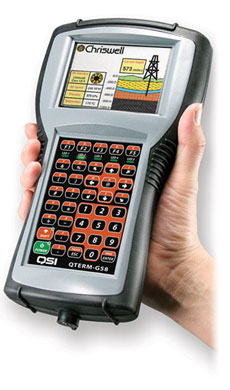|
QSI QTERM-G58
Ultra-rugged handheld graphic HMI terminal
(by Conrad H. Blickenstorfer)
While Salt Lake City, Utah based QSI calls its QTERM-G58 a handheld graphic HMI (Human Machine Interface) terminal, most would simply consider the device an ultra-rugged mobile computer for applications in areas where such hardened handhelds are used for,  like manufacturing, agriculture, asset management, process control, robotics, utilities and field service. There are, however, a number of features and qualities that make the QTERM unique. like manufacturing, agriculture, asset management, process control, robotics, utilities and field service. There are, however, a number of features and qualities that make the QTERM unique.
First of all, QSI has quite a bit of history in rugged handhelds. They've been in business for 30 years, and have been making industrial terminals for almost as long. QTERM handhelds have probably been environmentally tested for shock, vibration and humidity, and operation in extreme temperature ranges for longer than most. To get an idea of the extent of their testing, see QSI's Environmentally Hardened Rugged Terminals page.
While the QTERM-G58 has the general look, feel, and size of an industry-standard rugged handheld, that only applies in part. Yes, with a size of 5.1 x 9.2 x 2.0 inches and a weight of about a pound and a half, the QTERM is in the same range as some of the larger landscape-oriented displays terminals from the likes of Trimble, Two Technologies, Juniper Systems and a few more. And the transflective 3.5-inch 320 x 240 pixel QVGA resistive touch display is also familiar technology. Beyond that, QSI generally takes the road less travelled.
Under the hood sits an Atmel ARM926EJ-S processor, one that's rarely seen in industrial handhelds (see ddescription at ARM). It runs at a for today modest clock speed of 200MHz, but that's enough to drive Windows Embedded CE 6.0 (remember that the original IBM PC ran at less than 5MHz). What's unique here as well is that the QTERM can also run Qlarity, which is both a Beijer proprietary operating environment and also a well-supported object-based graphic programming language.
The keyboard is different also. While most industrial handhelds use individual physical keys, QSI uses steel-dome membranes for the high-contrast 24 or 40-key keypads of the QTERM. They operate with a noticeable snap, there are programmable LEDs to show alarms or indicate status, and the keypads can be customized with brands, company names and custom keys.

Wired connectivity is unusual as well with the QTERM. Instead of the usual USB or micro-USB port, QSI uses a 12-pin round multiprotocol Hirose port for software-selectable  EIA-232, -422, or -485 serial operation, and that port also supports USB. And unlike most industrial handhelds, the G58 can run on DC power or on its (non user-replaceable) internal battery. The internal battery itself is good for about ten hours of operation. EIA-232, -422, or -485 serial operation, and that port also supports USB. And unlike most industrial handhelds, the G58 can run on DC power or on its (non user-replaceable) internal battery. The internal battery itself is good for about ten hours of operation.
On the wireless communication side, there's optional dual antenna 802.11b/g, but nothing else. The G58 was not designed for comprehensive wireless voice/data and it doesn't double as a phone.
On the ruggedness and durability side, the Q58 can handle pretty much whatever you throw at it. That includes multiple 5-foot drops onto concrete, NEMA-4 sealing (which generally means a device can be hosed down), a very wide -4 to 140 degree operating temperature range, as well as resistance to shock and vibration and more.
Salt Lake City, Utah based QSI Corporation began operations in 1983 initially as a manufacturer of low-power bus board computers, and then also terminals. It was acquired in 2010 by Swedish Beijer Electronics and now designs and manufactures operator interface terminals for industrial, commercial and vehicle applications as Beijer's North American subsidiary.
|



